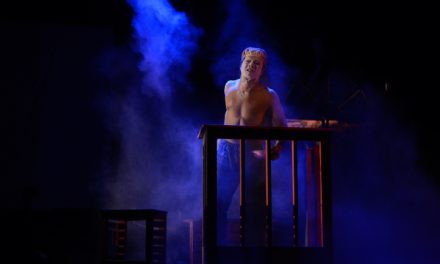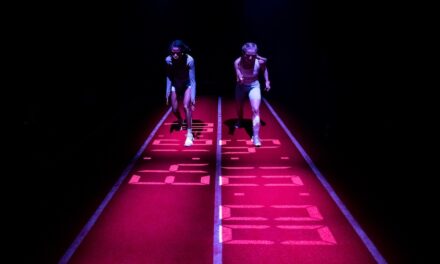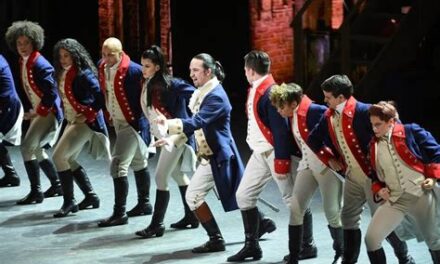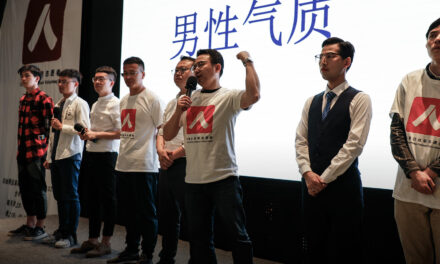In 2017, Los Angeles’ Center Theatre Group launched a new, and frankly exciting, idea known as Block Party wherein 3 out of the over 250 theatre companies in the city are chosen to remount productions from their most recent season with all of the support and resources the CTG has at their disposal. Each of the three productions is granted a little over a week in The Kirk Douglas Theatre in Culver City on the west side of LA. The second of the three this year is Critical Mass Performance Group’s Ameryka, written and directed by Nancy Keystone [Founding Artistic Director/Executive Producer], created in collaboration with the company.
In the lobby before the show one gentleman referred to the production as “ambitious” and though the word certainly does apply one might also add the words timely, moving and important to the list. There’s a lot to unpack in this two-and-a-half-hour exploration of the relationship between Poland and the United States that leapfrogs through time from The Revolutionary War and the first years of our new Republic to the late 1950’s and 60’s in both countries, through the 2000’s and the CIA’s use of black site Stare Kiejkuty–which makes one wonder what the future holds for both countries given our present political circumstances.
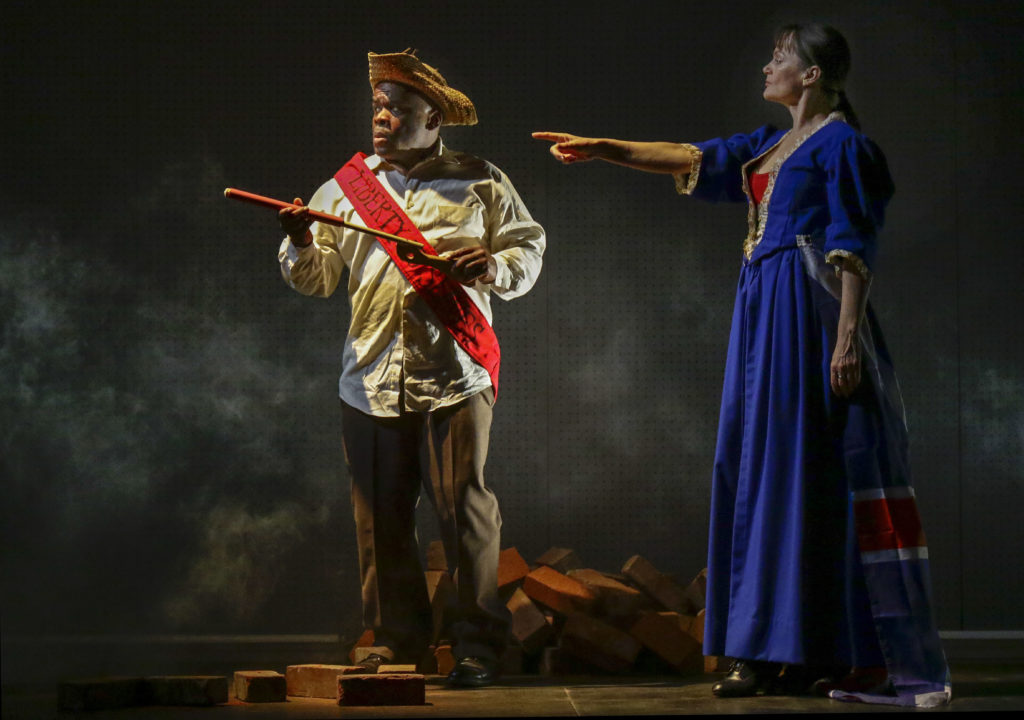
Ray Ford and Valerie Spencer. Photo by Lawrence K. Ho.
During the intermission, one woman turned to ask me “Why Poland?” Materials posted in the lobby reveals an image from the Polish Poster School in 1989 inspired the company to explore that question. Lifted out of High Noon, an image of Gary Cooper’s Marshall Will Kane appears on a white background with Solidarność appearing behind him. He wears a pin with that word on his vest above his Marshall star and carries a ballot instead of a gun. This iconic Marshall Kane, who waits for a train to arrive even though it fills him with dread, is ever-present throughout the piece with actors repeating the line “I need all the special deputies I can get” in different scenarios that alter its meaning over time.
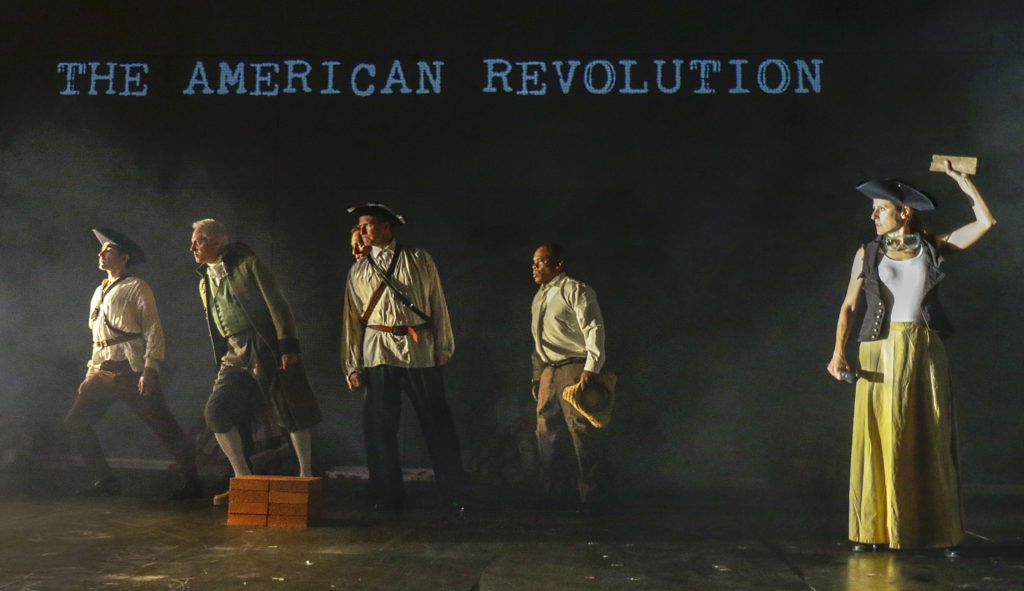
L-R: Richard Gallegos, Curt Bonnem, Nick Santoro (obscured), Russell Edge, Ray Ford and Liza Seneca. Photo by Lawrence K. Ho.
Truth plays a central role, as does the concept that the history we are taught about ourselves and our nation is not always the full story. There are “holes” in the history of both countries where we [or others] have skipped over or covered up darker realities we have yet to face–not the least being the impact slavery continues to have in the US and the impact torture and terror has had in Poland. Each of the nine ensemble members truly shines in moments as they take on one central role that either champions or hides truths before then morphing into a supporting character. They speak Polish one moment, a Polish-accent-infused English the next, then switch back to English without losing the sense of who they are or the message they are imparting to us.
Jeff Lorch’s role as Tadeusz Kościuszko and Lorne Green’s as his aide-de-camp, free slave Agrippa Hull reveal the role Kościuszko played not only in securing freedom for the US but also in creating the Polish-Lithuanian Commonwealth and Constitution in 1791 [the first of its kind in Europe]. These are names one might be hard-pressed to find in your average history textbook, yet we should know them.

L-R: Jeff Lorch, Ray Ford and Curt Bonnem. Photo by Lawrence K. Ho.
Curt Bonnem’s Thomas Jefferson is a masterful portrayal of this American mythical voice for freedom revealed to be just a man with a focus on his wallet. Russell Edge’s William J. Casey is an authority figure infused with the passion of an evangelical mission to free Poland [and Afghanistan, but we spend just enough time on that to make a necessary if not horrifying connection]. Lorne Green also plays CIA agent Curtis Brown, the only voice in a meeting that questions Casey’s plans for Poland. Ray Ford’s Gene Jefferson is a jazz musician who heartbreakingly finds he feels freer in Poland under Russian rule than he does in mid-20th century America.
Richard Gallegos appears as a ghost-like figure in multiple scenes as Native American Chief Little Turtle. Nick Santoro’s Agent Weller, Liza Seneca’s Polish underground reporter Ewa and Valerie Spencer’s role as Polish free trade union activist Anna Walentynowicz complete the basic overview of the cast but this is only a partial list of the characters they all bring to life with a physicality and emotional truth that keeps us engaged no matter how often we are shifted around in time and place. The gesture work is powerful, helping to underscore multiple thematic threads.
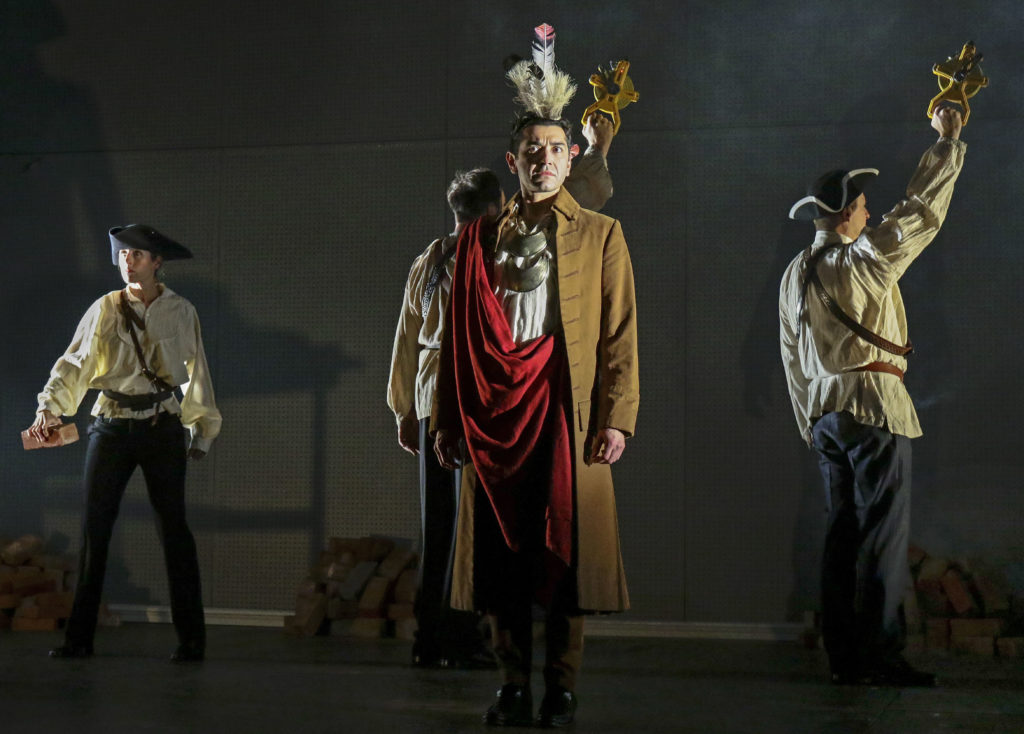
Richard Gallegos (center) and Liza Seneca (in background, other actors obscured). Photo by Lawrence K. Ho.
The set [by Nancy Keystone] is minimal with characters making inventive use of generic black chairs and white rolling tables. Piles of bricks stacked in uneven piles upstage become hand props that signify everything from America’s ignored treaties with the Native Americans to agreements made between Polish officials and the striking union workers in Gdansk to a suitcase full of broken government promises that Gene Jefferson unpacks in a raw, emotional scene that leaves one shaken. During the American Revolution, Ms. Seneca uses a brick to smash teacups lined up on a table while a horrified symbol of England in the body of Ms. Spencer looks on. When Mr. Lorch’s union-sympathetic Polish priest is captured and shot, the ensemble builds a brick memorial in his honor.
The piece could have been one such searing beat after another but there are moments of humor that accomplish more to get our minds thinking than we even realize at first. When Agrippa Hull [Mr. Green] stumbles upon a black man fighting for the king [Mr. Ford] the two comically fight in the dark and argue about possible outcomes of the war. Hull’s certainty they will be fully free men is undermined by a sudden blast of music and both men are pulled against their will into a song and dance number, lip-synching to Louis Armstrong and Louis Jordan’s duet Life Is So Peculiar. When Mr. Edge, Mr. Lorch, and Mr. Santoro appear seated around a table, dressed as black ops personnel stationed in Stare Kiejkuty they physically re-enact torturous horrors they inflict on unseen prisoners, interrupted repeatedly by Ms. Spencer in the guise of a hunched Polish cleaning lady who offers non-sequiturs about crocuses and other thoughts.
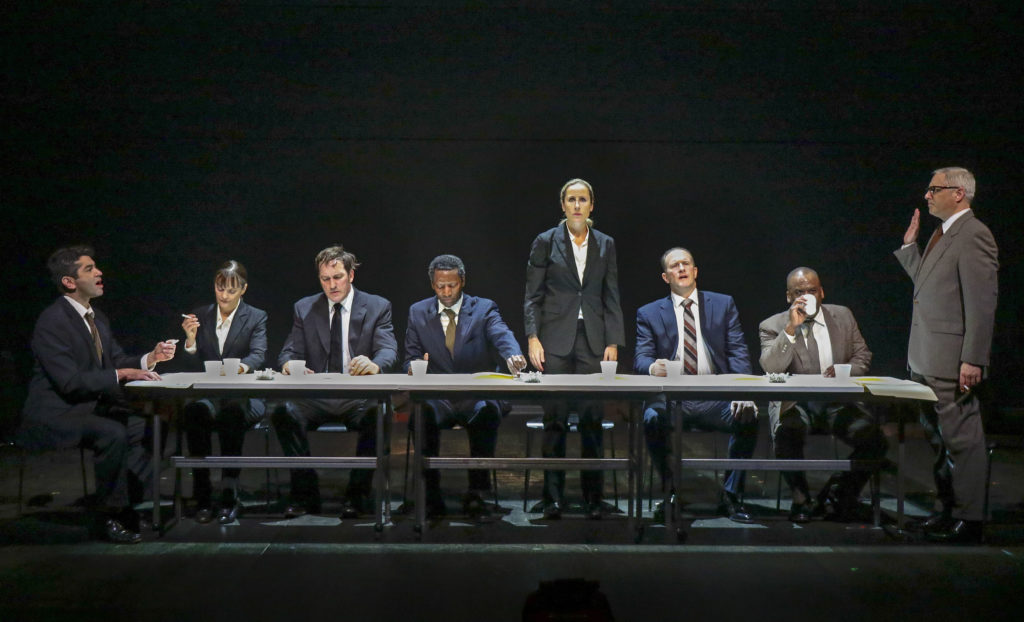
L-R: Richard Gallegos, Valerie Spencer, Nick Santoro, Lorne Green, Liza Seneca, Russell Edge, Ray Ford and Curt Bonnem. Photo by Lawrence K. Ho
Just as America earns its independence, Poland earns theirs, but it is a short-lived one that is followed by martial rule that resembles everything horrible they were fighting against–including the use of concentration camps. Just as the Poles felt they were making progress via a historic unity of the intelligentsia and the working class, they find themselves worse off than where they started. This kind of cultural whiplash might feel familiar to Americans who have not viewed the Trump Presidency as anything other than a nightmare from which they might hope to awaken.
Even when they earn their right to elect their own government the Poles find that government is not true to its people. Ewa’s [Ms. Seneca] response to Mr. Bonnem’s American reporter’s mere suggestion that Poland let the US use Stare Kiejkuty as a secret prison where torture was the rule rings out with the pain of deception that she will never recover from. Thomas Jefferson’s [Mr. Bonnem] panicked response to Kościuszko [Mr. Lorch] urging him to free his slaves stings–but not as badly as the news that Jefferson utterly disregarded Kościuszko dying wish to free those slaves by use of the money Kościuszko was owed for his work during the Revolution. These are hard things to swallow; we have no choice but to chew on them, as bitter as they are.
In the final moments of the play, Mr. Green told us about a painting of an angel but by this point, the delightful and painful web of characters, events, lies, betrayals, revelations, and revolutions had been cast so skillfully, it was difficult to recall the name of the artwork. We gather the angel is caught in a storm that prevents him from landing, prevents him from leaving. “This storm,” Mr. Green states, “is what we call progress.” And the lights go out, leaving us with that. Leaving us with more answers than we thought we were going to receive tonight and just as many questions stemming from those. Leaving us with characters who never find a resolution. Above all, leaving us with the responsibility–we have to figure out what we are going to do with all we have seen and felt and that is a supremely good thing. A piece like this should make us think, make us wonder, make us look up newspaper articles and learn. A piece like this is necessary at all times–especially now. Hats off to The Center Theatre Group for producing the Block Party in general and this piece in this beautiful theatre in particular.
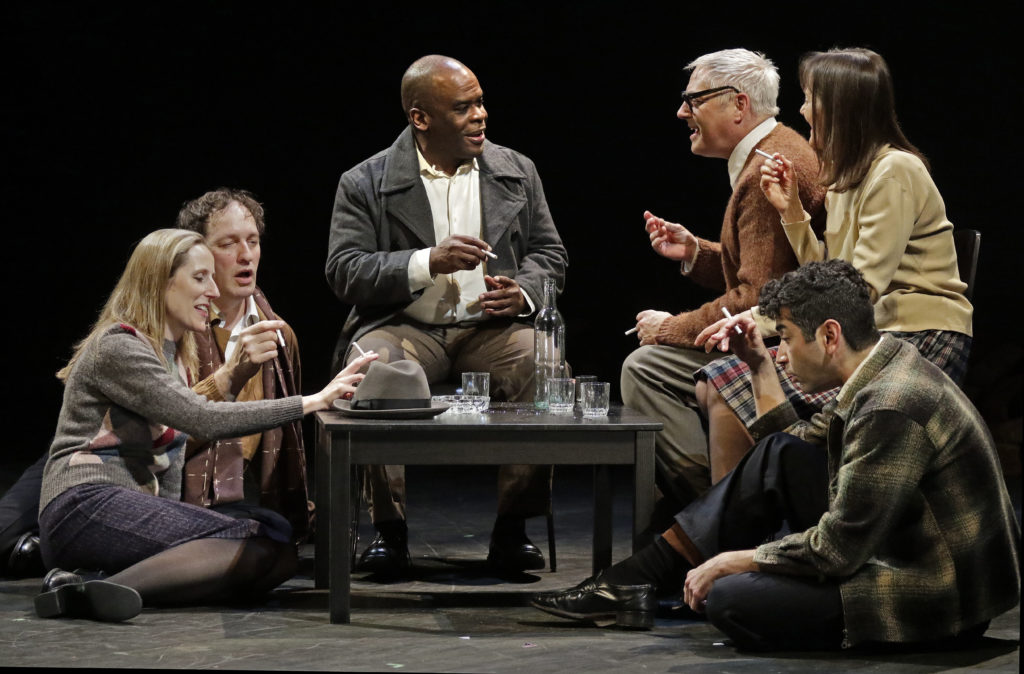
Clockwise from left: Liza Seneca, Nick Santoro, Ray Ford, Curt Bonnem, Valerie Spencer and Richard Gallegos. Photo by Lawrence K. Ho.
Scenic Design by Nancy Keystone.
The Costumes Designed by Lena Sands capture the different eras and characters very well.
Lighting Design by Adam J. Frank.
Sound Design & Original Music by Randall Robert Tico, who makes ingenious use of archival sound intercut with music and environmental audio that mesmerizes in its complexity and effectiveness.
Production Design by Hsuan-Kuang Hsieh.
Dramaturgy by Tom Bryant.
The Production Stage Manager is Susie Walsh and the Stage Manager is Maggie Swing.
Center Theatre Group Associate Producer is Lindsay Allbaugh.
Critical Mass Performance Group production of “Ameryka” Opens Saturday, April 21 at 8 p.m. (Previews April 19 and 20, 2018) Through April 29, 2018, at Center Theatre Group’s Kirk Douglas Theatre–9820 Washington Blvd., Culver City, CA 90232
Performance Days and Times: Tuesday through Friday at 8 p.m. Saturday at 2 and 8 p.m. Sunday at 1 and 6:30 p.m. No Monday performances. No matinee performances on April 21 and 22
“Ameryka” is performed with an intermission.
Tickets are available
- Online at www.CenterTheatreGroup.org
- By calling Center Theatre Group Audience Services at 213.628.2772
- In person at the Center Theatre Group Box Office at The Music Center
- At the Kirk Douglas Theatre two hours before curtain
This post was written by the author in their personal capacity.The opinions expressed in this article are the author’s own and do not reflect the view of The Theatre Times, their staff or collaborators.
This post was written by Christine Deitner.
The views expressed here belong to the author and do not necessarily reflect our views and opinions.


